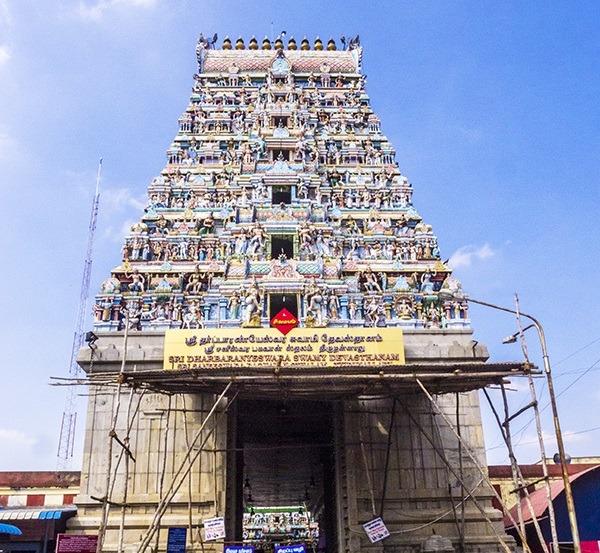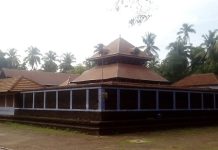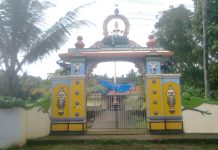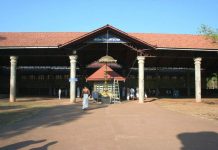Tirunallaru Darbaaranyeswarar Temple, also known as (Dharbaranyeswarar Temple or Thirunallar Temple), is a Hindu temple dedicated to Lord Shiva located in the town of Thirunallar in the Union Territory of Puducherry, India. It is one of the most famous temples in South India and attracts a large number of devotees every year.
The temple is known for its association with the planet Saturn (Shani), and is considered to be one of the most important pilgrimage sites for those seeking relief from the ill effects of Saturn. The presiding deity of the temple is Lord Darbaaranyeswarar (a form of Lord Shiva), and the goddess is Lordess Pranambigai (a form of Goddess Parvati).
The temple is located in a village 5 km away from Karaikkal in the Union territory of Puducherry and 95 km from Thanjavur. It has a rectangular plan with a five-tiered gateway tower called the rajagopuram. All the shrines are enclosed by granite walls. The presiding deity is believed to have been made of dharba grass. The sanctum also houses the image of Somaskanda, and niches around the sanctum have the images of Dakshinamurthy, Durga, and Lingodbhava. The temple also has a shrine dedicated to Shani, the planet Saturn. It is customary to worship Shani before entering the inner sanctum of Lord Shiva.
Legend
Long ago, in a village in South India, there lived a shepherd who was a devout follower of Lord Shiva. Every day, he would offer milk to the temple for the ablution of the presiding deity. One day, the government’s headman who lived nearby saw the shepherd offering milk and demanded that he give it to him instead of the temple. The headman threatened the shepherd not to reveal this to anyone, and out of fear, the shepherd complied.
The temple priest soon noticed that the temple was not receiving the usual amount of milk from the shepherd and informed the king. The king summoned the shepherd and asked him why he had disobeyed his order. Terrified of the headman’s threats, the shepherd remained silent, which enraged the king. The king ordered the shepherd to be executed.
The shepherd prayed to Lord Shiva to save him from the punishment. As he was about to be slaughtered, Lord Shiva appeared with his trident and stopped the execution. The altar of the temple was slightly moved from its original position as a reminder of this miraculous incident.
In another legend, the temple is associated with King Nala, who ruled a region full of tropical grass known as Darba. One day, Nala was afflicted by the negative effects of the planet Saturn due to his failure to practice cleanliness. He sought refuge in the temple and prayed to Lord Shiva to relieve him of the curse. It is said that Lord Shiva appeared and granted Nala’s wish, and since then, the temple has been associated with the planet Saturn.
People afflicted by the negative effects of Saturn visit the temple and take a holy dip in the temple tank, known as Nala Theertham, to relieve themselves of the curse. They also wear black clothes as a symbol of their devotion to Lord Shiva and seek his blessings. The temple’s sacred plant is Dharbai, which is believed to have grown in abundance in the region and is used in various rituals. The temple’s identity as a Navagraha sthalam is also significant, as it is represented by Lord Saneeswaran, the son of Lord Suryan and Chayadevi, and believed to be the lord of the Capricorn and Aquarius zodiac signs.
History
According to historical records, the Tirunallaru Darbaaranyeswarar Temple was built by the Chola kings who ruled the region in ancient times. Over the years, the temple has been known by different names such as Aadhipuri, Naleswaram and Nalavidangar.
Currently, the temple is managed by both the Dharumapuram Aadheenam and the Hindu Religious and Charitable Endowments Department of the Government of Tamil Nadu. It has stood the test of time and continues to be an important place of worship for devotees of Lord Shiva.
Architecture
The temple complex covers about two acres, and it has a number of shrines. The present masonry structure of the temple was built during the Chola dynasty in the 9th century, while later expansions are attributed to Vijayanagar rulers. The Department of Hindu Religious Institutions of the Government of Puducherry maintains and administers the temple. Other deities worshipped in the temple include Swarna Ganapathy, Murugan, Natarajar, Somaskandar, Kalahasthi Nathar, Pitchandavar, Nalvar, 63 Nayanmars, Adhisheshan, Nalanarayana Perumal, Mahalakshmi, Suryan, and Bairavar. The temple also has idols of King Nala and the lingam worshipped by him, along with idols of Vinayakar, Dakshinamurthy, Lingothbhavar, Brahma, Durgai, and Chandikeswarar in the koshtam. The temple also has a separate shrine for the Emerald lingam, Sri Thyagaraja Vidangar.
Festivals
The temple celebrates several festivals throughout the year, including the Mahasivarathri festival during the month of Chittirai (March – April), which is the most prominent festival for the presiding deity, and the Sanipeyarchi festival that occurs every 2.5 years, which is the most prominent festival for Lord Shani.
Devotees throng to the temple on all Saturdays to worship Lord Saneeswaran, as it is considered to be a very auspicious day for him. The full moon night in the Tamil month of Purattasi (September-October) is also significant, with special poojas performed to the Emerald Lingam.
The temple’s 18-day Brahmotsavam, celebrated in a grand manner, takes place in the Tamil month of Vaikasi (May-June). Additionally, all festivals related to Shiva temples are celebrated at this temple.
The most significant festival in the temple is the transition of Saturn, which happens once every two and a half years. Lakhs of devotees visit the temple to worship Lord Saneeswaran on this transition day, known as “Sani Peyarchi.”
The temple priests perform daily poojas (rituals) and during festivals. The rituals are performed six times a day, with each comprising four steps: abhishekam (sacred bath), alankaram (decoration), naivedyam (food offering), and deepa aradhanai (waving of lamps) for both Dharbaranyeswarar and Praneswari Amman. Music with nagaswaram (pipe instrument) and tavil (percussion instrument), religious instructions in the Vedas read by priests, and prostration by worshippers in front of the temple mast accompany the worship. Weekly rituals such as somavaram and sukravaram, fortnightly rituals such as pradosham, and monthly festivals such as amavasai (new moon day), kruttika, purnima (full moon day), and chaturthi are also observed.
Temple Timings
The temple is open for visitors from 6:00 AM to 12:00 noon and then again from 4:00 PM to 9:00 PM.
How to reach
Air: The nearest airport is located in Tiruchirapalli, which is approximately 70 km from the temple. From there, one can take a taxi or bus to reach the temple.
Rail: The nearest railway station is located in Karur, which is approximately 50 km from the temple. From there, one can take a taxi or bus to reach the temple.
Bus: The temple is well-connected by road, and buses are available from major cities in Tamil Nadu.
Road: The temple is located on the National Highway NH7 and is easily accessible by road. Taxis and buses are available from nearby cities to reach the temple.
























































